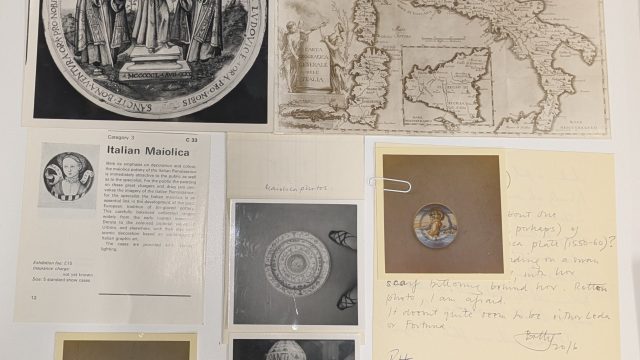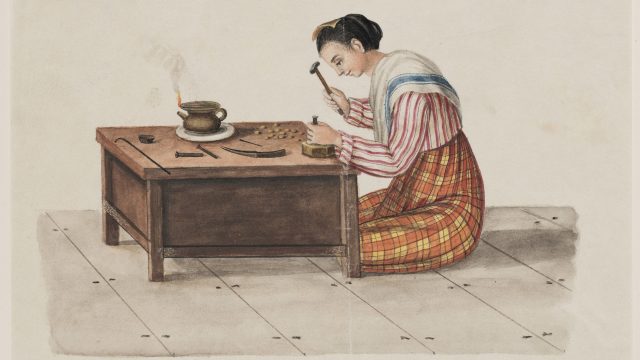by Catherine Haill, Curator, Popular Entertainment, Theatre & Performance and Marie de Lauzon, Paintings Conservator
The most famous nineteenth century tightrope-walking celebrity was the charismatic French showman Jean François Gravelet, or Blondin. Born in Hesdin near Calais in 1824, he was enrolled by his father, a dancer and tightrope-walker himself, in the École Gymnase at Lyons, aged five. Soon appearing as ‘The Little Wonder’ he stayed there until he was ten when he was orphaned and started work as a travelling entertainer. He adopted his stage name Blondin in 1851 when appearing with Antoine Ravel’s Troupe at Niblo’s Theatre in New York.
On seeing Niagara Falls for the first time in 1858, Blondin became obsessed with crossing them on a tightrope. He achieved his dream on 30th June 1859 on a three-inch hemp cord 1,100 feet long, holding a 30-foot long balance pole. He was the first ever to cross the Falls on a tightrope and immediately became a huge celebrity. He made repeat crossings with new effects, his third on 14th July in an ape costume, with the first of his brightly painted wheelbarrows. Made to his specifications by Thomas Duncan, the stage carpenter at the Buffalo Theatre, it had a grooved wheel for the rope and its handles fitted into loops in his costume, freeing his hands for the balance pole.
Blondin made six crossings in 1859 and 1860, sometimes blindfolded, carrying his manager on his back, even stopping halfway to cook on a portable stove. He balanced on chairs, turned somersaults, walked on fork-ended stilts, and ferried passengers piggy-back at £5 a trip (Figure 1). He even asked the Prince of Wales watching a ‘Royal Command’ performance on 18 September 1860 if he could carry him across. He was amused by his refusal.
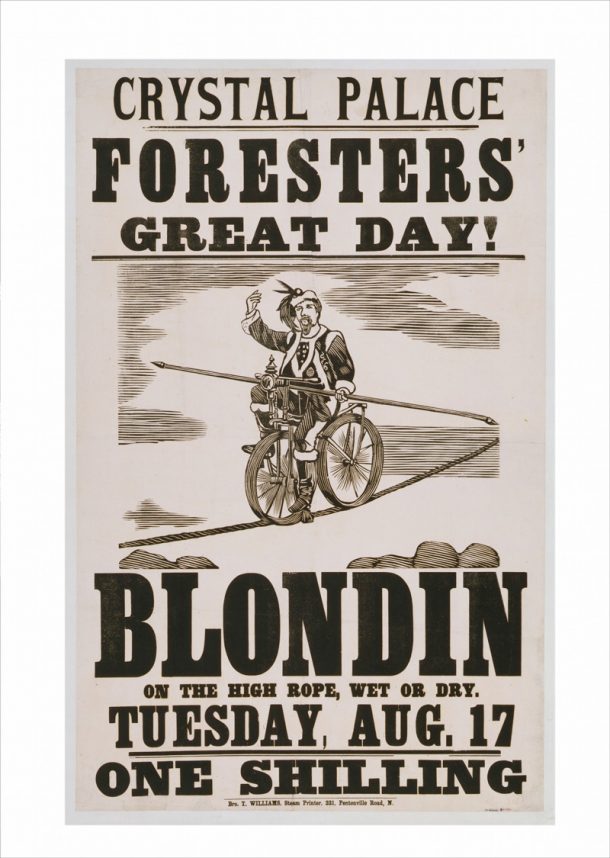
On Blondin’s first London appearance on 1 June 1861 to a capacity audience at the Crystal Palace, he re-enacted his Niagara Falls stunts on a rope across the central transept, 70 feet above ground (Figure 2). His performance there on 15th June with his five-year old daughter Adèle in a wheelbarrow scattering roses to the audience below caused so much consternation that letters appeared in the press, questions were asked in Parliament and the directors were told that it must never be repeated. On a UK tour the following year he ferried a lion in a wheelbarrow at Liverpool Zoological Gardens instead.
Blondin retired in London a very rich man. R. Fleming Lowell even wrote a song about him. He made over 4,000 performances throughout his lifetime and was still performing at the age of 68. His home Niagara House was in Northfields, near Ealing (then called Little Ealing) where he died in 1897 aged 73, and where Blondin Avenue and Niagara Avenue were named in his memory.
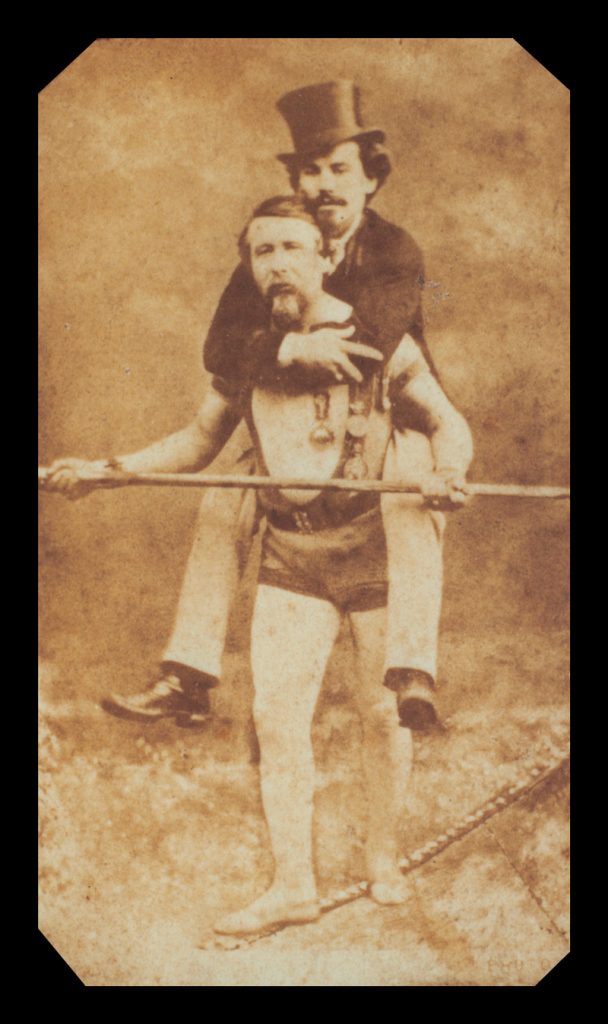
The wheelbarrow in the V&A’s collection (S.279-1985) would have been used to transport passengers in some of Blondin’s many tightrope crossings during his remarkable career. The ‘seat’ section of the wheelbarrow is made of five panels of wood. The seat is mounted onto two long wooden members which form the handles at one end and hold the wheel at the other. The wheel has a groove where it was in contact with Blondin’s rope. These lengths are held together in a ladder-like fashion with four wooden cross members. The parts are held together with metal bars, screws and wing nut bolts. The chair is lined with dark red felt and the wheelbarrow, including the wheel, is painted a white creamy colour with decorative lines of gold leaf.
The wheelbarrow was in poor condition. The structure had distorted over time and exposure to environmental changes had caused delamination and splitting in the wood. The painted surface was worn with losses and flaking and the surface extremely dirty with a dull grey appearance. The gilded areas had been overpainted with bronze paint which had oxidised and appeared brown. The red felt had also suffered over time and was detatching from the wood. As this object was on show during spectacular events such as the crossing of the Niagara Falls, it would have been highly decorative; therefore, the aim of the treatment was to bring back its stunning appearance while retaining the marks of its history and use.
Nigel Bamforth, Senior Furniture Conservator, stabilised the wooden structure and split timbers were re-instated in their correct position so that the original profile could be maintained. Warm hide glue was used with clamps to hold the timber in position. Degraded and flaking old adhesive in the areas lined with felt was mechanically removed with tweezers. Following consultation with Textile Conservators, 1 part Lascaux 360HV:2 parts Lascaux 498 was applied to the reverse side of the lifting felt and gently repositioned.
The flaking paint was consolidated with isinglass, an aqueous adhesive thermo-adhesive. A layer of Japanese tissue was stuck with methylcellulose to the surface to hold the flakes during the treatment. The adhesive was introduced under the flakes using a syringe to allow an accurate fixing. The adhesive was left to dry overnight and then the flakes were gently ironed with a hot spatula to go back in plane. After this process the tissue was removed with deionised water.
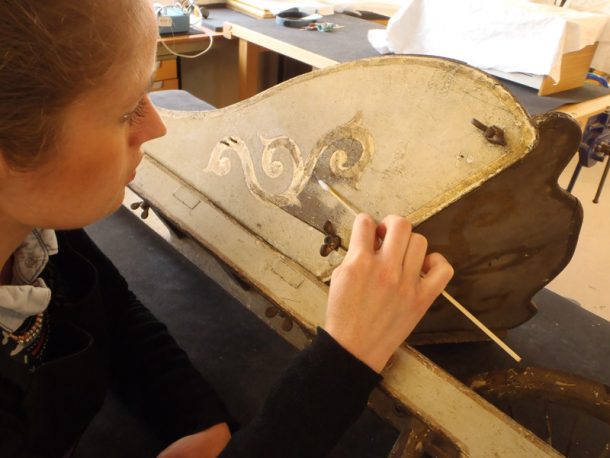
Cleaning of the surface was crucial to recover the contrast and the original colour of the decorative surface (Figure 3). The surface was cleaned with 3% Triamonium Citrate in deionised water. The gilded decoration was cleaned with 5% sodium hydroxide. The surface was then rinsed with deionised water. Although the original varnish was aged and yellow, it was decided to keep it as it is part of the history of the object.
The wheelbarrow was very much in use by Blondin and the subsequent wear to the painted surface is part of its history, therefore areas of loss showing wood below were not retouched. Larger losses to the paint were left and unified with the rest of the surface using soft glazes of watercolour. The paint and the gilded decoration were retouched with a water-based pigment palette. A mix of ochre, ultramarine, red oxide, black and ivory were used on all the painted areas. As the original varnish was kept, an isolation layer was not added between the painting and the retouching.

The conserved wheelbarrow (Figure 4) is now on display in Theatre and Performance, Rooms 103 – 106.
Given by The Wellcome Institute for the History of Medicine
